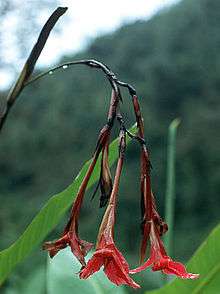Canna iridiflora
| Canna iridiflora | |
|---|---|
 | |
| Scientific classification | |
| Kingdom: | Plantae |
| (unranked): | Angiosperms |
| (unranked): | Monocots |
| (unranked): | Commelinids |
| Order: | Zingiberales |
| Family: | Cannaceae |
| Genus: | Canna |
| Species: | C. iridiflora |
| Binomial name | |
| Canna iridiflora Ruiz. & Pav. | |
Canna iridiflora Ruiz & Pav. is a species of the Canna genus, belonging to the family Cannaceae, a native of Peru, Columbia and Costa Rica at altitudes of 1,800–2,850 m (5,910–9,350 ft). It was introduced to England in 1816 (Johnson's Gardeners Dictionary, 1856). Not to be confused with C. iridiflora Wild., which is a synonym for C. indica.
It is a perennial growing to 5 m. It is hardy to zone 10 and is frost tender. In the north latitudes it is in flower from August to October, and the seeds ripen in October. The flowers are hermaphrodite.
Synonyms
- Peruvian Canna
- Iris Canna
Taxonomy
In the last three decades of the 20th century, Canna species have been categorised by two different taxonomists, Paulus Johannes Maria Maas from the Netherlands and Nobuyuki Tanaka from Japan. They are in agreement that this is a distinct and separate Canna species.
Canna iridiflora Ruiz & Pav.
Flowers hanging down in large pendants of pink, riding above large, green leaves. Spreading stems and gently spreading leaves creates a goblet shaped clump. Plant height 5 m (16 ft). The foliage is green (137A) with pale inner edge and dark outer edge. Flowers are pendant shaped carmine-red to purple, 10–14 cm (4-5½ in) long, with a relatively long tubular part and 8 coloured lobes; petals not reflexed; staminodes 4.
References
- Cooke, Ian, 2001. The Gardener's Guide to Growing cannas, Timber Press. ISBN 0-88192-513-6
- Johnson's Gardeners Dictionary, 1856
- Tanaka, N. 2001. Taxonomic revision of the family Cannaceae in the New World and Asia. Makinoa ser. 2, 1:34–43.